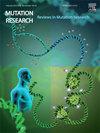Cytotoxicity of allyl isothiocyanate and its metabolites in hepatocellular carcinoma HepG2 cells
IF 1.5
4区 医学
Q4 BIOTECHNOLOGY & APPLIED MICROBIOLOGY
Mutation Research-Fundamental and Molecular Mechanisms of Mutagenesis
Pub Date : 2025-01-01
DOI:10.1016/j.mrfmmm.2025.111899
引用次数: 0
Abstract
Objective
To investigate the mechanisms by which allyl isothiocyanate (AITC) exerts its anticancer effects, the present study investigated the cytotoxic effects of AITC and its metabolites on hepatocellular carcinoma HepG2 cells.
Methods
The AITC metabolites, S-(N-allylthiocarbamoyl)-L-glutathione (AITC-GSH), N-acetyl-S-(N-allylthiocarbamoyl)-L-cysteine (NAC-AITC), S-(N-allylthiocarbamoyl)-L-cysteinylglycine (AITC-Cys-Gly), and S-(N-allylthiocarbamoyl)-L-cysteine (AITC-Cys) were synthesized. HepG2 cells were treated with these compounds and AITC and subjected to a cell cycle analysis, HPLC analysis for intracellular AITC metabolites, and intracellular reactive oxygen species (ROS) analysis.
Results
AITC, AITC-GSH, and NAC-AITC significantly induced cell cycle arrest in the G2/M phase and subsequently enhanced apoptotic cell death. The AITC metabolites, AITC-Cys-Gly and AITC-Cys did not induce cell cycle arrest. A correlation was observed between the intracellular concentration of AITC-GSH and the percentage of cells under G2/M arrest after the treatments with AITC, AITC-GSH, and NAC-AITC. AITC derived from HepG2 cells treated with AITC-GSH and NAC-AITC conjugated with endogenous GSH, resulting in an increase in ROS levels. A treatment with a ROS inhibitor canceled cell cycle arrest.
Conclusion
The conjugation of intracellular GSH with AITC decreased free reduced GSH levels and increased intracellular ROS levels in HepG2 cells, resulting in cytotoxicity, including cell cycle arrest and apoptosis.
异硫氰酸烯丙酯及其代谢物对肝癌HepG2细胞的细胞毒性
目的探讨异硫氰酸烯丙酯(allyl isothiocyanate, AITC)的抗肿瘤作用机制,研究AITC及其代谢物对肝癌HepG2细胞的细胞毒作用。方法合成AITC代谢产物S-(n -烯丙基硫代氨基甲酸酯)- l-谷胱甘肽(AITC- gsh)、n -乙酰基-S-(n -烯丙基硫代氨基甲酸酯)- l-半胱氨酸(NAC-AITC)、S-(n -烯丙基硫代氨基甲酸酯)- l-半胱氨酸(AITC- cys - gly)、S-(n -烯丙基硫代氨基甲酸酯)- l-半胱氨酸(AITC- cys - gly)和S-(n -烯丙基硫代氨基甲酸酯)- l-半胱氨酸(AITC- cys - gly)。用这些化合物和AITC处理HepG2细胞,并进行细胞周期分析、细胞内AITC代谢物的HPLC分析和细胞内活性氧(ROS)分析。结果saitc、AITC-GSH和NAC-AITC显著诱导细胞周期阻滞在G2/M期,随后增强凋亡细胞死亡。AITC代谢物、AITC- cys - gly和AITC- cys不诱导细胞周期阻滞。AITC、AITC- gsh和NAC-AITC处理后,细胞内AITC- gsh浓度与G2/M阻滞细胞百分比呈正相关。AITC来源于HepG2细胞,经AITC-GSH和NAC-AITC结合内源性GSH处理,导致ROS水平升高。用ROS抑制剂治疗可以消除细胞周期阻滞。结论AITC与细胞内GSH结合可降低HepG2细胞游离还原GSH水平,增加细胞内ROS水平,引起细胞毒性,包括细胞周期阻滞和细胞凋亡。
本文章由计算机程序翻译,如有差异,请以英文原文为准。
求助全文
约1分钟内获得全文
求助全文
来源期刊
CiteScore
4.90
自引率
0.00%
发文量
24
审稿时长
51 days
期刊介绍:
Mutation Research (MR) provides a platform for publishing all aspects of DNA mutations and epimutations, from basic evolutionary aspects to translational applications in genetic and epigenetic diagnostics and therapy. Mutations are defined as all possible alterations in DNA sequence and sequence organization, from point mutations to genome structural variation, chromosomal aberrations and aneuploidy. Epimutations are defined as alterations in the epigenome, i.e., changes in DNA methylation, histone modification and small regulatory RNAs.
MR publishes articles in the following areas:
Of special interest are basic mechanisms through which DNA damage and mutations impact development and differentiation, stem cell biology and cell fate in general, including various forms of cell death and cellular senescence.
The study of genome instability in human molecular epidemiology and in relation to complex phenotypes, such as human disease, is considered a growing area of importance.
Mechanisms of (epi)mutation induction, for example, during DNA repair, replication or recombination; novel methods of (epi)mutation detection, with a focus on ultra-high-throughput sequencing.
Landscape of somatic mutations and epimutations in cancer and aging.
Role of de novo mutations in human disease and aging; mutations in population genomics.
Interactions between mutations and epimutations.
The role of epimutations in chromatin structure and function.
Mitochondrial DNA mutations and their consequences in terms of human disease and aging.
Novel ways to generate mutations and epimutations in cell lines and animal models.

 求助内容:
求助内容: 应助结果提醒方式:
应助结果提醒方式:


